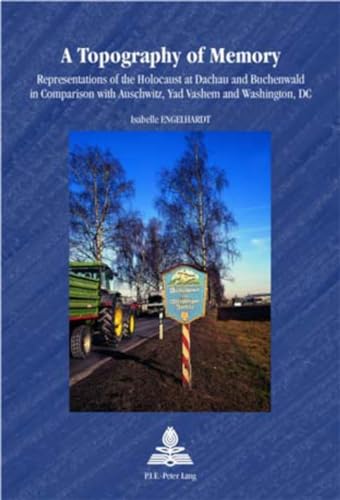topography memory representations holocaust de engelhardt isabelle (3 résultats)
Filtres de recherche
Type d'article
- Tous les types de produits
- Livres (3)
- Magazines & Périodiques (Aucun autre résultat ne correspond à ces critères)
- Bandes dessinées (Aucun autre résultat ne correspond à ces critères)
- Partitions de musique (Aucun autre résultat ne correspond à ces critères)
- Art, Affiches et Gravures (Aucun autre résultat ne correspond à ces critères)
- Photographies (Aucun autre résultat ne correspond à ces critères)
- Cartes (Aucun autre résultat ne correspond à ces critères)
- Manuscrits & Papiers anciens (Aucun autre résultat ne correspond à ces critères)
Etat En savoir plus
- Neuf (3)
- Comme neuf, Très bon ou Bon (Aucun autre résultat ne correspond à ces critères)
- Assez bon ou satisfaisant (Aucun autre résultat ne correspond à ces critères)
- Moyen ou mauvais (Aucun autre résultat ne correspond à ces critères)
- Conformément à la description (Aucun autre résultat ne correspond à ces critères)
Reliure
- Toutes
- Couverture rigide (Aucun autre résultat ne correspond à ces critères)
- Couverture souple (3)
Particularités
- Ed. originale (Aucun autre résultat ne correspond à ces critères)
- Signé (Aucun autre résultat ne correspond à ces critères)
- Jaquette (Aucun autre résultat ne correspond à ces critères)
- Avec images (1)
- Sans impressions à la demande (3)
Langue (1)
Prix
- Tous les prix
- Moins de EUR 20 (Aucun autre résultat ne correspond à ces critères)
- EUR 20 à EUR 45 (Aucun autre résultat ne correspond à ces critères)
- Plus de EUR 45
Livraison gratuite
- Livraison gratuite à destination de France (Aucun autre résultat ne correspond à ces critères)
Pays
Evaluation du vendeur
-
A Topography of Memory: Representations of the Holocaust at Dachau and Buchenwald in Comparison with Auschwitz, Yad Vashem and Washington, DC (Europe plurielle/Multiple Europes)
Edité par P.I.E-Peter Lang S.A., Éditions Scientifiques Internationales, 2002
ISBN 10 : 9052019576 ISBN 13 : 9789052019574
Langue: anglais
Vendeur : Ria Christie Collections, Uxbridge, Royaume-Uni
EUR 53,87
Autre deviseEUR 4,60 expédition depuis Royaume-Uni vers FranceQuantité disponible : 2 disponible(s)
Ajouter au panierEtat : New. In.
-
A Topography Of Memory: Representations Of The Holocaust At Dachau And Buchenwald In Comparison With Auschwitz, Yad Vashem And Washington, Dc
Edité par College of Europe Pubns, 2002
ISBN 10 : 9052019576 ISBN 13 : 9789052019574
Langue: anglais
Vendeur : Revaluation Books, Exeter, Royaume-Uni
EUR 53,10
Autre deviseEUR 11,52 expédition depuis Royaume-Uni vers FranceQuantité disponible : 2 disponible(s)
Ajouter au panierPaperback. Etat : Brand New. 237 pages. 8.50x6.00x0.75 inches. In Stock.
-
A Topography of Memory : Representations of the Holocaust at Dachau and Buchenwald in Comparison with Auschwitz, Yad Vashem and Washington, DC
Vendeur : AHA-BUCH GmbH, Einbeck, Allemagne
EUR 54,95
Autre deviseEUR 10,99 expédition depuis Allemagne vers FranceQuantité disponible : 1 disponible(s)
Ajouter au panierTaschenbuch. Etat : Neu. Druck auf Anfrage Neuware - Printed after ordering - There is a paradox inherent in any attempt to memorialize the Holocaust. On the one hand, it can be argued that the Holocaust is fundamentally unrepresentable, indeed unimaginable, and that no human means of communication can adequately convey its enormity. On the other hand, any memorial devoted to the Holocaust is predicated on the notion that the only way to ensure that such a thing does not happen again is to bear witness and thereby 'bring the living and the dead together'. But how can something that cannot be represented be remembered or witnessed This book is an analysis of the history of various sorts of representation, chiefly memorials, on the site of the concentration camps Dachau and Buchenwald in comparison with Auschwitz, Yad Vashem and the US Holocaust Memorial Museum in Washington, DC. By providing a reconstruction of the history and debates surrounding the question of memorializing and forgetting, it interrogates the question of how to represent the unrepresentable. It is a study of how the boundaries of representation and the rhetoric of artifacts changed during the transformation of these places. It draws on Freudian analysis, the literature on sites of memory, and the debate about writing about the Holocaust, showing clearly how the camps have been and still remain highly contested places of memory and arguing that these debates and their physical embodiment on the sites have to be incorporated in our understanding of what these places represent.



